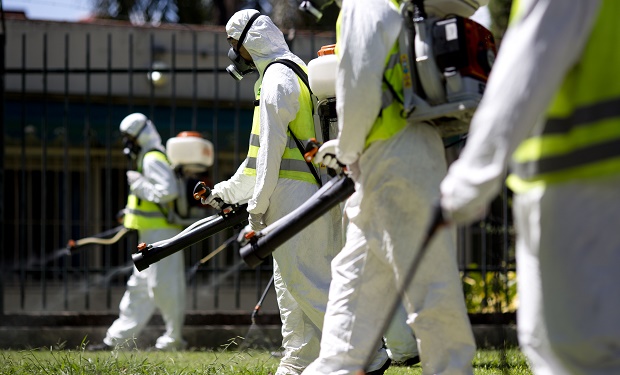Undetected Zika in our midst?

In this Jan. 27, 2016 file photo, a fumigation brigade sprays an area of Chacabuco Park in a Aedes mosquito control effort, in Buenos Aires, Argentina. The Zika virus is suspected of causing a rare but potentially devastating birth defect, an abnormally small head, which can indicate underlying brain damage. Concerns are keeping some workers from attending meetings and company retreats in affected locations but business travel experts say it does not yet appear to be having a broad impact. AP FILE PHOTO
OUR DEPARTMENT of Health (DOH) has been doing a great job in making sure serious infections like those caused by the Ebola, severe acute respiratory syndrome, and avian flu viruses don’t reach our shores; and if they do, the cases are promptly contained to prevent an outbreak.
Recently, there is another global concern about another viral infection, carried by the Aedes aegypti—the same mosquitoes carrying the dengue virus. As if being the vector of the dengue virus is not bad enough, Aedes aegypti mosquitoes are really reinforcing their image of being the tiniest mass killer and source of illness and serious inborn abnormality.
In a recent statement, the DOH assured that the Philippines is still free of the Zika virus, which has been reported to cause microcephaly in babies of women infected with the virus during pregnancy.
Microcephaly is an inborn abnormality in which an infant’s head is significantly smaller than the heads of other children of the same age and sex. It may be detected at birth, but in many instances, it can only be identified when the baby is a few months or a few years old because of their small heads compared to other infants and children of the same age and sex.
Because of the small heads, brain development is affected resulting in developmental issues like mental and physical retardation, facial distortions, dwarfism or short stature, difficulty in walking and maintaining balance, and occurrence of seizures or convulsions.
‘Hot spots’
To date, at least 14 countries and territories in Central and South America and the Caribbean have been labeled as “hot spots” for Zika infection.
Isolated cases have also been reported in the United States and Australia—all of whom were returning travelers from Latin American countries. No local transmission of the viral infection has been reported so far.
Mild symptoms
The clinical presentation may be quite deceiving, with relatively mild symptoms like fever, joint pains, skin rash, and mild conjunctivitis or sore eyes. The symptoms usually last only for a few days, rarely extending beyond a week. It can be easily dismissed as a mild touch of flu.
In fact four out of five infected individuals are relatively symptom-free. Hardly anyone with Zika infection needs hospital admission and there is no reported mortality from the infection. But the effect on the fetus of infected pregnant women can be devastating.
Why do I sound so edgy about the Zika virus? Simply for one reason. Wherever the Aedes aegypti mosquitoes thrive, the Zika virus can thrive, too, and spread like bushfire. The whole country has now become a breeding ground for these mosquitoes, as evidenced by the year-round presence of dengue infections.
The difficult part about detecting a Zika outbreak is that it may already be in our midst without us realizing it. Most cases have no symptoms and relatively mild symptoms manifest in those who have. The symptoms don’t seem to be a cause for worry.
Because of this deceitful clinical presentation, it can spread in a territory very slyly like a furtive thief without calling attention to it.
Detecting Zika infection
It’s only when its drastic complications—microcephaly and other probable congenital or inborn abnormalities— have reached alarming proportions that the country realizes the extent of damage its tiny invaders have caused.
It is possible that we already have the Zika in our midst, but are just not able to detect the infected cases because of their asymptomatic or relatively mild clinical presentation.
Another reason why detecting Zika infection is a problem even to seasoned public health experts is that diagnosing the presence of the virus remains a challenge.
The Center for Disease Control (CDC) in the United States recommends several tests like blood tests in the suspected infected mother using reverse-transcription polymerase chain reaction (RT-PCR) within one week of symptom onset.
Alternatively, antibody testing from the blood can be done within the first three days after symptom onset.
After four or more days of infection, its sensitivity and specificity markedly decrease as there can be cross-reactivity to other types of flaviviruses, especially the dengue virus.
Amniotic fluid testing may also be done using RT-PCR, though its sensitivity and specificity are yet unknown.
The hitch is that these tests are not commercially available yet; and specimens need to be sent to the CDC and other special centers for testing.
Our DOH should have a protocol requiring all hospitals —both government and private—to report all cases of microcephaly to detect any remarkable increase in occurrence compared to historical records.
Our best bet is to prevent the infection, and that is, by eradicating all possible breeding grounds for the Aedes aegypti mosquitoes.
It would be well worth every peso spent for it if the DOH could once again intensify this campaign by fogging particularly crowded areas, and implementing massive public information programs on preventive measures to get rid of all potential breeding areas in our homes and backyards.
This way we can kill two birds with one stone—dengue and Zika.
